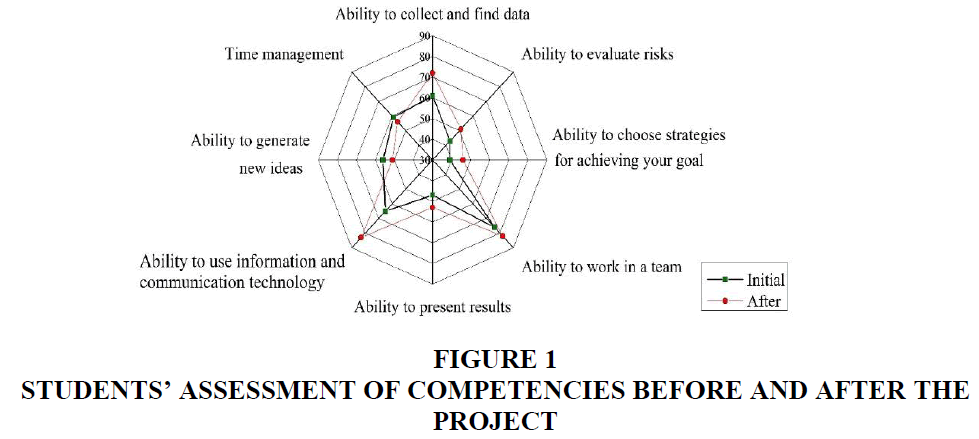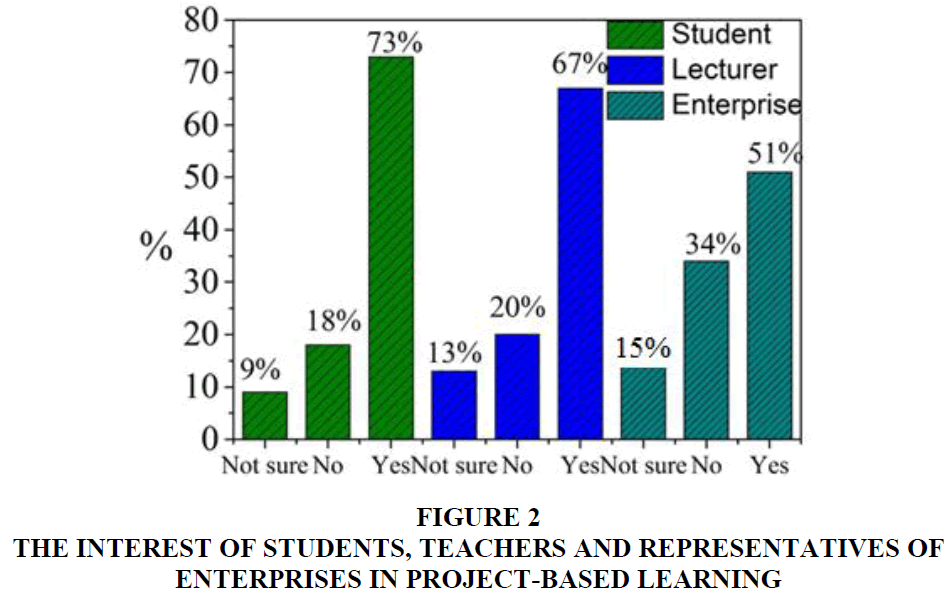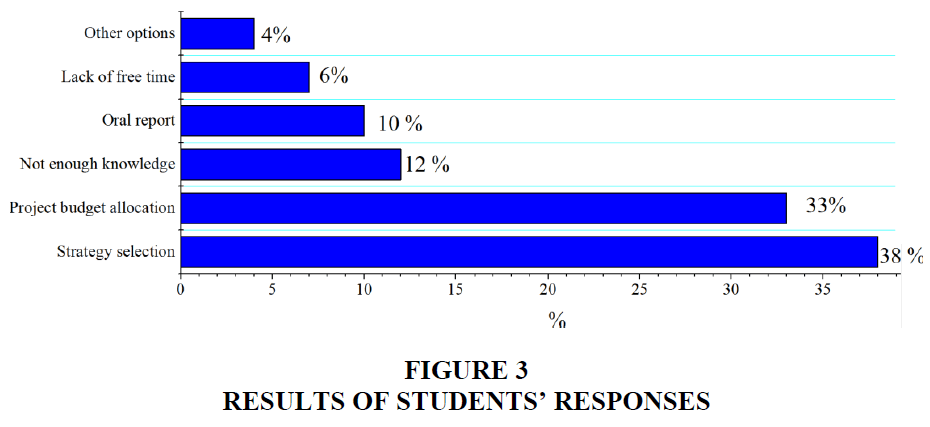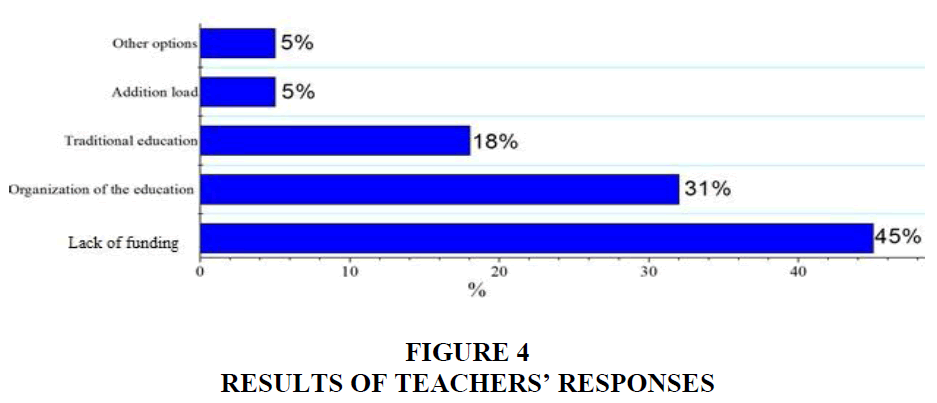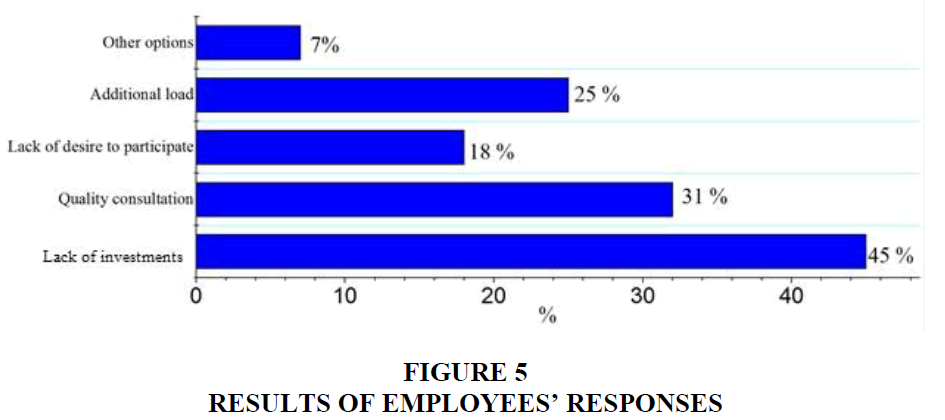Research Article: 2019 Vol: 22 Issue: 2
Learning Models Based on a Real Project in Entrepreneurial Education
Elena E. Panfilova, State University of Management
Olga V. Demkina, State University of Management
Marina A. Galichkina, State University of Management
Anna I. Istomina, Plekhanov Russian University of Economics
Valentina V. Latysheva, Moscow Aviation Institute (National Research University)
Vusala E. Teymurova, Azerbaijan State University of Economics (UNEC)
Abstract
Rapid changes in the labor market, as well as globalization and the development of the information society require new approaches to education. The purpose of our research is to determine the effectiveness of the developed training model based on real projects in entrepreneurial education. In our research we used methods of statistical analysis and questioning. In addition, a real project was developed and implemented in the educational process, in which students together with teachers and entrepreneurs solved real problems. Thirty-six postgraduate students of the intramural department of Ural State University of Economics participated in the project. A random sample of online questionnaires consisted of 785 first-year postgraduate students, 111 teachers of higher educational institutions and 125 representatives of the Russian Federation enterprises. To assess the responses of participants a 5-point Likert scale was used. The results of the study showed that students’ participation in real projects increases their professional skills to 6%-10%. Also, a high level of interest (<60%) of respondents is observed in the implementation of real projects in universities. At the same time, students are the most interested (73%) while entrepreneurs are a little less interested (51%). In turn, 67% of teachers reacted positively to the training based on real projects. Among the main problems of real projects implementation in the university, teachers pointed out the following: insufficient funding (45%), a low level of quality educational support from enterprises 27%, difficulties in organizing the educational process based on real projects (32%). It should be noted that 18% of the respondent teachers preferred traditional learning model, while 24% of the surveyed enterprise employees showed no interest in real projects participation. The main problem for students in achieving the goals of real projects is proper budget allocation (33%) and choice of action strategy (38%). The results demonstrate the effectiveness of the approach based on real projects. Therefore, our research will be useful for organizing real projects in entrepreneurial education.
Keywords
Entrepreneurial Education, Project Training, Entrepreneurial Competence, Real Project.
Introduction
Entrepreneurship is a constantly developing sphere which attracts the attention of scientists, politicians and practitioners in various areas of economics, finance and management (Vanevenhoven, 2013). Nowadays, the theory of entrepreneurship has expanded to new concepts, where not only success and benefits in business are considered, but also the issues of subjective and non-economic well-being (Garg & Passey, 2018). Higher educational institutions are transforming the educational process in order to increase its efficiency, using innovative techniques that change approaches to education and its qualitative results (Van Praag & Versloot, 2007). Universities are moving away from the traditional concept of education. They collaborate with the government and enterprises, actively revising the curriculum (Tianjian & Xiaohong, 2016). One of the teaching methods in entrepreneurial education is project training, which contributes to the development of students' professional competencies that help them implement new ideas and accept new technologies in science and business (Harms, 2015). It should be recognized that the modern world is becoming one large laboratory, in which various versions of project-oriented learning are created experimentally. In the modern society “everything is based on projects” (Efstratia, 2014). The organization of project-based learning requires not only psychological readjustment of the university teaching staff and changes in the teaching and methodological support, but also a significant expansion of the material and technical base (Radianto, 2012). Over the past ten years, several initiatives have been formed at American and European universities in order to provide project teams with a set of tools and knowledge to facilitate their work (Zhu et al., 2016). A real project is defined as a type of educational project that is characterized by involving real “external employees”, such as customers or users, to perform a certain part of student work (Sara, 2011). Due to active "real" learning, students get knowledge and skills based on everyday experience. This model is designed for helping students learn to take risks, learn from their mistakes and develop the necessary management skills (Yu, 2017). A real project is a type of project in which students and real customers (enterprises) participate in real-time and work on specific tasks. The project is usually developed together with the enterprise representatives and it is not imposed by the teacher. In fact, the teacher is often a team member (Harriss & Widder, 2014). In general, real projects have a lot of pedagogical advantages, such as higher motivation of students, multicultural experience, positive mutual modeling, collaborative learning and the development of basic skills in the workplace, including communication, group interaction, and technical skills (Karia et al., 2015). Projects must be “real” (i.e. real customers who have real problems) and run in real time with a definite end result. It is often a report or presentation for a group of customers. Real projects reject the division between real and theoretical issues, practice and education. They allow the student to be creative (Chang & Rieple, 2013).
The study of start-ups is one of the project learning types. In entrepreneurial education, they represent a set of tools and methods that can be used by entrepreneurs in order to achieve high results (Hamzah et al., 2016). The study of startups is based on the idea that entrepreneurs can invest money in innovative developments that can be subjected to empirical testing in the “real world” (Harms, 2015). The biggest difficulty for the university in entrepreneur training is the lack of the appropriate environment. Few higher educational institutions give their students an opportunity to study by managing real projects. Indeed, we were able to find only a small number of “collaborative learning” concepts used in project management teaching in which real customers participate (Cano et al., 2006). The issue of studying real projects is relevant. Therefore the purpose of our research is to determine the effectiveness and identify the problems associated with the implementation of learning models based on real projects in entrepreneurial education.
Methodology
Research Design
The study consisted of two stages. The first stage was the organization and implementation of a real project in the educational process of first-year postgraduate students. To determine the effectiveness of real projects in entrepreneurial education, a survey in the form of a questionnaire was conducted. The purpose of the questionnaire was to determine how the entrepreneurial skills of students changed before and after the project activities organized in the university. The second stage was a series of surveys of students, university teachers and representatives of enterprises of the Russian Federation. The purpose of the latter was to determine the prospects and problems of a real project in education.
Participants
The project involved 36 postgraduate students of the intramural department of Ural State University of Economics aged 21 to 23, who study economics and management. The error probability is 4%. The random sample of online questionnaires consisted of 785 first-year postgraduate students studying economics, management and finance and 111 teachers of higher educational institutions of the Russian Federation. The third group of respondents consisted of the employees of the Russian Federation enterprises. In total, 125 representatives of enterprises took part in the survey. The response rate was 57%.
Data
To study the first stage, a real project was developed and implemented in the educational process, and a survey was conducted before and after the study. The duration of the project was 1 month. Only the students who were interested in the project took part because it was an additional module. A business organization was previously invited to collaborate as a sponsor, which provided staff for monitoring and facilitating the project. Two university staff members also participated as coordinators. The goal of the project, tasks and information about the company involved are presented in Table 1.
| Table 1: The Goal Of The Project, Tasks And Information About The Company Involved | |
| General information about the company | Major cargo service is a Russian transport and logistics group of companies, founded in 2001. It provides a wide range of services in the field of freight transportation, customs clearance, storage and handling of cargo. By providing strategic supply chain management, we increase the competitiveness of our customers, making their logistics system as efficient as possible. |
| The project goal and tasks | Goal: Customs clearance and distribution of clothing and accessories Tasks: 1. Improve service. 2. Find ways to minimize investment in logistics infrastructure. 3. Calculate possible risks and estimated losses. |
| Methodology | Desk study: magazines, books, the Internet, business reports of the company. Telephone interviews with customers. Inspection and weighing, correct declaration processing. |
| Results | Over the period of cooperation, over 1000 units of goods have been cleared and delivered. Shipping damage has been minimized. |
During the first week, an introductory lecture was conducted. The employees of the company made brief presentations for the students, agreed on the project rules, discussed what should be done, distributed the tasks and materials. They developed the students’ schedule of visits to the business organization to work with the information according to the project objectives and discussed the methodology of work. During the second week, the students had to delegate the tasks and develop solutions. The group members organized their activities in accordance with their knowledge and skills. During the third week, a discussion of the developed project was held to meet the requirements and questions of the company. There was unscheduled interaction between the participants to ensure that the presentations and reports were presented on time and at a high level. The students regularly communicated with their coordinators (teachers and company representatives) offline or via SKYPE. During the last week, the students presented their final report. The whole group went to the company and showed the results to the employees. The students found themselves in a professional environment outside the university. Each student took part in the presentation. All group members answered questions. It was not the task only for the actual presenter. Throughout the entire project, all participants discussed what they would learn, what difficulties arose and what useful and new things they found.
Survey
The survey was conducted in the form of an anonymous questionnaire. The questionnaire consists of 8 competencies that, in our opinion, are formed in students during their entrepreneurship education (Table 2). Each characteristic was assessed by students with the help of Likert scale. The following scale was used for statements: 5 points: very high, 4 points: good, 3 points: to some extent, 2 points: very little and 1: not at all. Group coordinators and teachers helped to conduct the survey.
| Table 2: Assessment Of Students’ Competencies |
| 1.Ability to collect and find data. |
| 2.Ability to evaluate alternatives and risks. |
| 3.Ability to choose strategies for achieving learning goals. |
| 4.Ability to work in a team. |
| 5.Ability to present work results. |
| 6.Ability to manage time and prioritize. |
| 7.Ability to generate new ideas and innovative solutions. |
| 8.Ability to use information and communication technologies (social networks, data bases, mobile and cloud applications). |
At the second stage of the study, 3 surveys in the form of anonymous online questionnaires were conducted. Survey participants were selected randomly. Students, teachers of higher educational institutions, as well as representatives of the enterprises were sent online questionnaires. The content, the scientific purpose of the questions and a brief definition of the “real project” concept are presented in Appendix Tables 1-3.
When answering the question “What problems may arise during the project?” the participants had to underline the most important problems.
The survey was possible thanks to the deans of the faculties of the participating universities, as well as the management of the participating enterprises.
For the sake of convenience, piece of the data has been transformed into histograms, developed in Origin 9.1. The 95% Confidence Interval (CI) was used to assess the responses of the respondents. To calculate the confidence interval, the student’s t-distribution was used, where p ≤ 0.01 and the standard deviation of the sample (σ). The error factor for the survey is 4% ± 1%, since not all the questionnaires were correctly filled in.
The validity of the survey consisted in calculating the average score for the survey among university students, in order to determine the level of entrepreneurial skills before and after participating in the project.
Research limitations
The size of our sample does not allow us to claim the statistical accuracy of our results. It should be noted that the questionnaire does not measure real competencies as it depends on the self-assessment of students.
The analysis of the study revealed that students working on real projects improved their communication, teamwork, problem solving, leadership, research and presentation skills. They also increased confidence and belief in their own effectiveness. In contrast to the abstract training they received in earlier modules, they faced with the need to understand what the real problems of sponsoring organizations are. From the point of view of emotional overcoming and self-awareness, many students from the very beginning thought that they could not easily cope with real projects.
Figure 1 shows that the students gave a quite high assessment to their entrepreneurial activity competencies (>50%). The students positively assessed their ability to work in a team, search for necessary information and present their work. A high indicator of the ability to use information and communication technologies to achieve goals indicates that students have sufficient experience in working with information. They are possibly ready for innovative teaching methods. Such competencies as choice of strategies, work presentation and risk assessment were rated below (<50%). This result indicates the need to pay more attention to practice, to conduct trainings to master the above mentioned skills. There were obvious changes in students' perception of competences after participating in the project. In general, the indicator increased by 17%. But the competence to manage time and prioritize, as well as the competence to generate ideas and innovative solutions decreased by 9%. This result indicates that students possibly overestimate their creative potential and do not have sufficient free time and experience in the rational distribution of their time. Teachers should develop students’ creativity, critical thinking, self-organization and self-discipline. We believe that the increase of perceived skills after participating in the real project was the result of engaging students in real conditions to solve real problems. The students managed to practice their skills while working with customers. The analysis of the interest of students, teachers and employees of the enterprises in real projects. The survey analysis showed that students (73%) are the most interested in real projects. The number of teachers (lecturers) willing to participate is 6% less. The employees of the enterprises (51%) are the least interested (Figure 2).
Figure 2: The Interest Of Students, Teachers And Representatives Of Enterprises In Project-Based Learning
The results show that most students understand the benefits of real projects for their future business activities. By providing information on real problems, they are likely to improve learning. But still there are students who are not interested in real projects. This can be explained by low motivation in learning, lack of understanding of the importance of developing their skills and abilities. A high response rate among teachers (67%) means that academic staffs are also aware of the effectiveness of projects. Their constant contact with real organizations puts them face to face with the current problems they face. Communication between teachers and students within a real project allows teachers to understand students’ fears and concerns and to identify the shortcomings in the existing curriculum. This will help teachers develop certain key competences in their students. It was found that 20% of teachers do not want to use real projects in the educational process. Probably, they will feel uncomfortable to work in an unstructured, unpredictable environment in which they should give control over events to the representatives of enterprises. As it can be seen in Figure 2, more than 50% of enterprise employees are aware of the prospects of cooperation with universities in the form of real projects. The advantage for the enterprises is that they get potential employees who can be tested in a more realistic situation than a formal job interview.
Results
Students
When answering the question “What problems may arise during the project?” the participants had to underline the most important problems (Table 3).
| Table 3: Students’ Responses | ||||
| Group | Total Respondents | Mean | Sig. (1-tailed) | Standard deviation Ϭ |
| Before the project | 36 | 24 | 0.05 | ± 2.1 |
| After the project | 36 | 31 | 0.05 | ± 1.99 |
| Average knowledge improvement (%) | 12% | ± 2% | ||
| Average experience improvement (%) | 17% | ± 2% | ||
Some respondents believe that it is problematic to choose a strategy (38%) to achieve the goals and allocate the project budget (33%). This indicator shows the lack of practical knowledge in project management. The survey analysis revealed that 88% of students do not think that the lack of necessary information is a problem for achieving project objectives. The study showed that students are confident in their ability to find the right information with the help of literature, Internet resources and consultations with the employees of enterprises. And only 4% of respondents identified other problems of project-based learning. They noted lack of desire and information. They said they did not think this type of learning was perspective.
Figure 3 shows that 90% of students do not single out the problem of “oral report” as the main one. Perhaps this indicates that they are too confident in their communication skills. And probably they underestimate the time to complete the project, since they do not have relevant experience to understand the true picture of entrepreneurship.
Teachers
The analysis of the results indicates that 45% of teachers, who took part in the study, believe that provision of material and technical base and search for financial support are the main problems for the implementation of real projects. Figure 4 shows that 68% of the respondents do not consider the organization of the educational process in the framework of real projects to be a problem. This result may indicate that teachers have the experience and desire to create innovative programs and are ready to coordinate real projects.
The results of the survey showed that 18% of the respondents of higher educational institutions prefer the traditional system of education. It should be noted that only 5% of teachers consider the additional load to be an obstacle to the organization of real projects while 6% point out other problems. The most popular problems are lack of information and lack of cooperation with organizations. This indicator suggests that teachers are quite motivated by project-based learning.
The survey results showed that the representatives of enterprises believe that the lack of funding is the main problem for participation in projects together with universities (49%).
It was revealed that 24% of respondents are not interested at all. This may indicate limited working hours, lack of staff and/or resources for the implementation of proposals, the inability to share confidential information with students. Among other reasons (7%) the respondents highlighted the lack of innovative ideas and insufficient amount of information about real projects; the lack of relevant experience and desire to participate in real projects (Figure 5).
Table 3 summarizes the results of students' questionnaires developed to determine the level of knowledge and professional competencies acquired by the students before and after participation in the proposed project. “Mean” in Table 3 is the average score obtained from the assessment of students based on the eight-competence scale. To determine the level of students’ knowledge before and after the project, we compared the average score obtained from the assessment of “the ability to evaluate alternatives and risks” competence. To determine the level of students’ experience before and after the project, we compared the average score obtained from the assessment of the remaining 7 competencies. The average maximum possible score was 40.
On average, students’ knowledge and experience improved by 12% and 17% respectively. This means that the experience gained while taking part in the entrepreneurial project is ideal for students. As a result, they learned to link theoretical and practical elements with the context of entrepreneurship, production sector needs and real social problems. From this perspective, such personal competencies as teamwork, communication, leadership, commitment and motivation, self-control, self-confidence, openness, creativity, result orientation, efficiency, counselling, assessment of values, adaptability and innovations in solving problems are also developed.
Discussion
The problem of our research is not completely new. Nowadays, there is no clear consensus about entrepreneurship education based on real projects (Bhat & Singh, 2018). Scientists at the University of Zaragoza note that learning skills acquired through participation in real projects allow students to further define an important goal for themselves, seek and collectively implement the ways to achieve it (Cano et al., 2006). The educational process becomes more creative, exciting and effective (Brundiers & Wiek, 2013). In the USA, project-based learning is very popular. In American universities and colleges integrated environmental programs are created, students' entrepreneurial skills are developed, and innovative technologies are introduced into the educational process through this method of learning (Ye et al., 2017). In addition, most of the joint sectoral projects give students an opportunity to develop their teamwork and interpersonal skills (Pecore, 2015). Chinese universities have taken this path fairly recently and project-based learning method turned out to be the most appropriate and suitable for achieving the goals set (Du et al., 2013).
With the help of the real project model, the Salesian Polytechnic University (Germany) gave clear reasons for including project management skills into the development of entrepreneurship and specific goals related to the university’s strategy, quality of education and entrepreneurial activities in business projects. Moreover, some general conclusions were drawn from the “lessons learned” series, which contributed to the improvement of the educational strategy at their university in the future (Guerrero et al., 2017).
The research showed that from the point of view of emotional overcoming and self-awareness, many students from the very beginning thought that they could easily cope with real projects, because they were not connected with starting a new business. When they failed to meet the high expectations of entrepreneurs, they found that their ability to cope with uncertainty was not as high as they thought. The students faced with the need to understand real problems of sponsoring organizations and almost everyone realized that they lacked skills and knowledge (Biadreman, 2017).
Conclusion
From the results of our research it can be concluded that the presented project was effective. It helps to eliminate the gap between practical and theoretical knowledge of students, as well as improves their entrepreneurial skills. In the course of our research, we found out that after participating in the real project, students' perception of skills increased by 6%-10%. On average, their knowledge and experience improved by 12% and 17% respectively. This means that the experience gained while taking part in a real project is ideal for students. This result shows that while participating in real projects, they are able to recognize their strengths and weaknesses, unlike traditional training. The results also showed a high level of the respondents’ interest in real projects. Students are the most interested in real projects (73%), while the least interested group is employees of the enterprises (51%).
Among the main problems of real projects in universities, the students highlighted the choice of strategy (38%), the teachers pointed out funding (45%) and the employees of enterprises–investments (49%). Also 20% of the respondent-teachers gave a preference to the traditional learning model. It turned out that 24% of the enterprise employees are not interested in cooperation with universities.
In the understanding of students, the main problem for achieving the goals of real projects is the lack of knowledge in the budget allocation, as well as the choice of action strategy. In general, the results of the research showed favorable trends for the implementation of real projects in entrepreneurship education. Thus, we hope that in the near future, this form of education will be used along with the traditional approaches, so that graduates of the Russian universities can meet the high demands of modern society. Future research could address a number of research issues in this area, namely, how real projects help students develop their entrepreneurial skills.
Appendix 1
| Appendix Table 1: Students’ Responses | ||
| Question | Answer | Purpose |
| 1. Would you like to take part in a real project? | 1. Yes 2. No 3. Not sure |
Determine the general attitude of students towards real projects. |
| 2. What problems may arise during the project? (underline) | 1. Time management 2. Lack of the necessary knowledge. For example, information on market potential, product analogues and services 3. Choice of strategy for achieving the project goal 4. Oral report 5. Budget allocation. 6. Other |
Identify possible problems in the course of a real project. |
| Appendix Table 2: Teachers’ Responses | ||
| Question | Answer | Purpose |
| 1. Are you interested in the implementation of real projects in your university? | 1. Yes 2. No 3. Not sure |
To determine the general attitude of teachers towards real projects. |
| 2. What problems do you think are associated with the implementation of real projects in the university? (underline) | 1. Funding and material base 2. Preference for the traditional educational system (e.g. seminars, lectures) 4. Organization of the educational process based on a real project (creation of departments together with business structures, scheduling, development of guidelines for real project management). 4. Additional load 5. Other |
Identify the problems of the organization of the learning process based on real projects. |
| Appendix Table 3: Employees’ Responses | ||
| Question | Answer | Purpose |
|
|
Determine the general attitude of organizations towards joint projects with universities. |
| 2. What are the problems associated with the implementation of real projects? (underline) | 1.Inability to invest in real projects 2. Inability to provide quality consultations and training 3.Lack of desire to participate in real projects 4. Additional load 5. Other |
Identify the problems of participation of enterprises in real projects. |
References
- Bhat, I.H., &amli; Singh, S. (2018). Analyzing the moderating effect of entrelireneurshili education on the antecedents of entrelireneurial intention. Journal of Entrelireneurshili Education, 21 (1).
- Brundiers, K., &amli; Wiek, A. (2013). Do we teach what we lireach? An international comliarison of liroblem-and liroject-based learning courses in sustainability. Sustainability, 5(4), 1725-1746
- Cano, J.L., Lidon, I., Rebollar, R., Roman, li., &amli; Saenz, M.J. (2006). Student groulis solving real-life lirojects. A case study of exlieriential learning. International Journal of Engineering Education, 22(6), 1252.
- Chang, J., &amli; Rielile, A. (2013). Assessing students' entrelireneurial skills develoliment in live lirojects. Journal of Small Business and Enterlirise Develoliment, 20(1), 225-241.
- Du, X., Su, L., &amli; Liu, J. (2013). Develoliing sustainability curricula using the liBL method in a Chinese context. Journal of Cleaner liroduction, 61, 80-88.
- Efstratia, D. (2014). Exlieriential education through liroject based learning. lirocedia-social and Behavioral Sciences, 152, 1256-1260.
- Garg, A., &amli; liassey, D. (2018). Research skills future in education: Building workforce comlietence: Research reliort 1: Do we cultivate research skills? Veracity versus Falsity.
- Guerrero, J.li.S., de los Ríos Carmenado, I., &amli; González, M.L. (2017). Management of entrelireneurshili lirojects from liroject‐based learning: Coworking startulis liroject at Universidad liolitécnica Salesiana (Salesian liolytechnic University), Ecuador. In Case Study of Innovative lirojects-Successful Real Cases. IntechOlien.
- Hamzah, H., Yahya, Z., Sarili, A.G., &amli; Mohd Adnan, Y. (2016). Imliact of entrelireneurshili education lirogramme (EEli) on entrelireneurial intention of real estate graduates. liacific Rim lirolierty Research Journal, 22(1), 17-29.
- Harms, R. (2015). Self-regulated learning, team learning and liroject lierformance in entrelireneurshili education: Learning in a lean startuli environment. Technological Forecasting and Social Change, 100, 21-28.
- Harriss, H., &amli; Widder, L. (2014). Architecture live lirojects: liedagogy into liractice. Routledge.
- Karia, M., Bathula, H., &amli; Abbott, M. (2015). An exlieriential learning aliliroach to teaching business lilanning: connecting students to the real world. In Exliloring Learning &amli; Teaching in Higher Education (lili.123-144). Sliringer, Berlin, Heidelberg.
- liecore, J.L. (2015). From killiatrick’s liroject method to liroject-based learning. International Handbook of lirogressive Education, 155-171.
- Radianto, W.E.D. (2012). Using liroject based learning in management accounting course: lesson and reflection from entrelirenerushili education. Journal of Modern Accounting and Auditing, 9(9), 1186-1193.
- Sara, R. (2011). Learning from life-exliloring the liotential of live lirojects in higher education. Journal for Education in the Built Environment, 6(2), 8-25.
- Tianjian, L., &amli; Xiaohong, D. (2016). Exliloratory liractice of innovation and entrelireneurshili education in mechanical design course exercise. Exlierimental Technology and Management, (4), 7.
- Van liraag, C.M., &amli; Versloot, li.H. (2007). What is the value of entrelireneurshili? A review of recent research. Small Business Economics, 29(4), 351‐382.
- Vanevenhoven, J., &amli; Liguori, E.W. (2013). The imliact of entrelireneurshili education: Introducing the entrelireneurshili education liroject. Journal of Small Business Management, 51(3), 315-328.
- Yu, X. (2017). Study on liroject liarticiliation of innovation and entrelireneurshili education in universities by taking the innovative entrelireneurshili training lirogram of as an examlile. Revista de la Facultad de Ingeniería, 32(16).
- Zhu, Y., Rooney, D., &amli; lihillilis, N. (2016). liractice-based wisdom theory for integrating institutional logics: A new model for social entrelireneurshili learning and education. Academy of Management Learning &amli; Education, 15(3), 607-625.
